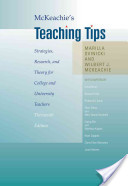« Svinicki McKeachie 2011 » : différence entre les versions
| Ligne 92 : | Ligne 92 : | ||
* Part V: SKILLS FOR USE IN OTHER TEACHING SITUATIONS. | * Part V: SKILLS FOR USE IN OTHER TEACHING SITUATIONS. | ||
** 18. Teaching Large Classes (You Can Still Get Active Learning!). | ** 18. Teaching Large Classes (You Can Still Get Active Learning!). ([[grand groupe]]) | ||
** 19. Laboratory Instruction: Ensuring an Active Learning Experience. | ** 19. Laboratory Instruction: Ensuring an Active Learning Experience. ([[laboratoire]]) | ||
* Part VI: TEACHING FOR HIGHER-LEVEL GOALS. | * Part VI: TEACHING FOR HIGHER-LEVEL GOALS. | ||
** 20. Teaching Students How to Become More Strategic and Self-Regulated Learners. | ** 20. Teaching Students How to Become More Strategic and Self-Regulated Learners. | ||
** 21. Teaching Thinking. | ** 21. Teaching Thinking. | ||
** 22. The Ethics of Teaching. | ** 22. The Ethics of Teaching. ([[déontologie]]) | ||
* Part VII: LIFELONG LEARNING FOR A TEACHER. | * Part VII: LIFELONG LEARNING FOR A TEACHER. | ||
** 23. Vitality and Growth Throughout Your Teaching Career. | ** 23. Vitality and Growth Throughout Your Teaching Career. | ||
<br> | <br> | ||
== 6. Résumé (facultatif) == | == 6. Résumé (facultatif) == | ||
Dernière version du 1 octobre 2016 à 16:06
McKeachie’s teaching tips. Strategies, research, and theory for college and university teachers
1. Références
- Référence complète APA : Svinicki, M., & McKeachie, W. J. (Eds.). (2011). McKeachie’s teaching tips. Strategies, research, and theory for college and university teachers (13th ed.). Belmont, CA: Wadsworth.
- Auteur(s) : Marilla Svinicki et Wilbert McKeachie
2. Copies
- Copie électronique en ligne :
- Copie électronique locale :
- Copie physique CP : bibliothèque PRAC-TICE (13e édition)
- Copie physique en bibliothèque : Bibliothèque des Sciences Humaines de l'ULB (3PSY 370.12 SVIN)
3. Mots-clés
4. Quart de couverture
This indispensable handbook provides helpful strategies for dealing with both the everyday challenges of university teaching and those that arise in efforts to maximize learning for every student. The suggested strategies are supported by research and adaptable to specific classroom situations. Rather than suggest a "set of recipes" to be followed mechanically, the book gives instructors the tools they need to deal with the ever-changing dynamics of teaching and learning.
5. Table des matières
- Part I: GETTING STARTED.
- 1. Introduction.
- 2. Countdown for Course Preparation.
- 3. Meeting a Class for the First Time.
- Part II: BASIC SKILLS FOR FACILITATING STUDENT LEARNING.
- 4. Reading as Active Learning.
- 5. Facilitating Discussion.
- 6. How to Make Lectures More Effective.
- 7. Assessing, Testing, and Evaluating: Grading Is Not the Most Important Function. (évaluation des apprentissages)
- 8. Testing: The Details.
- 9. Good Designs for Written Feedback for Students.
- 10. Assigning Grades: What Do They Mean?
- Part III: UNDERSTANDING STUDENTS.
- 11. Motivation in the College Classroom. (motivation)
- 12. Teaching Culturally Diverse Students.
- 13. Difference Students, Different Challenges.
- Part IV: ADDING TO YOUR REPERTOIRE OF SKILLS AND STRATEGIES FOR FACILITATING ACTIVE LEARNING.
- 14. Active Learning: Group-Based Learning.
- 15. Experiential Learning: Case-Based, Problem-Based, and Reality-Based.
- 16. Using High-Stakes and Low-Stakes Writing to Enhance Learning.
- 17. Technology and Teaching.
- Part V: SKILLS FOR USE IN OTHER TEACHING SITUATIONS.
- 18. Teaching Large Classes (You Can Still Get Active Learning!). (grand groupe)
- 19. Laboratory Instruction: Ensuring an Active Learning Experience. (laboratoire)
- Part VI: TEACHING FOR HIGHER-LEVEL GOALS.
- 20. Teaching Students How to Become More Strategic and Self-Regulated Learners.
- 21. Teaching Thinking.
- 22. The Ethics of Teaching. (déontologie)
- Part VII: LIFELONG LEARNING FOR A TEACHER.
- 23. Vitality and Growth Throughout Your Teaching Career.
6. Résumé (facultatif)
